For decades, dynamite or blast fishing and cyanide fishing has been destroying our coral reefs , but up to this day it is still widespread though there are efforts to build artificial reefs in the Philippines, the root cause must still be eradicated.
Cyanide fishing is harmful. “It is a deadly poison not only to people and fish, but also to other marine animals like corals,” deplored Dr. Rafael D. Guerrero III, a fishery scientist with the National Academy of Science and Technology (NAST).
When people talk of corals, they usually think of those structures in the shallow waters of the seas. But these are actually remnants of fragile creatures called polyps, tiny animals that absorb calcium carbonate from seawater and excrete limestone, from which reefs are made.
The ornate, visually stunning structures are vital for the health of surrounding waters. They host microscopic organisms on which larger creatures feed and provide shelter for a variety of marine life like fish, lobsters, octopi, eels, and turtles.
Fishermen use cyanide illegally to catch fish that hide in coral reefs. A study commissioned by the Bureau of Fisheries and Aquatic Resources (BFAR) in 1982 established that two applications of cyanide on coral reefs four months apart caused high coral polyp mortality.
“Unlike blast fishing, which reduces corals into rubble,” explains marine scientist Vaughan R. Pratt, “cyanide fishing keeps coral intact, but dead.”
Fifty percent of the fish exposed to sodium cyanide die in the reef. The ones caught and later recovered are transferred to clean water, but they are doomed to die within weeks or months because of the damage caused by poison to their internal organs.
Another way to destroy the coral reefs is through Land Reclamation. For every addition of land, there are coral reefs and mangroves destroyed.
MANILA BAY LAND RECLAMATION
The environmental impacts and economic benefits must be balanced, but somehow the environmental impacts outweigh the economic benefits.
Land reclamation expands territories for residential, commercial, and industrial purposes, thus, promises the creation of economic opportunities through massive capital investment, the much-touted needed jobs and livelihood opportunities.
“While proponents of these reclamation projects promise economic development, we see that environmental impacts outweigh economic development,” Agham told Business Mirror.
The group said Manila Bay reclamation will adversely affect the environment through mangrove cutting, seabed dredging and dumping of soil on the coast, Agham said via e-mail through its Public Information Officer Jerwin Baure.
According to Agham, other environmental impacts of the project will involve seabed quarrying, or massive dredging of sand beneath the sea in Manila Bay, including those in Bataan and Pampanga, for the filling materials.
“The environmental impacts of reclamation are not only in the proposed site but also [in areas] where the filling materials will be sourced just like in the case in the ‘dolomite beach’ in Manila wherein the filling materials came from a mountainous area in Cebu,” the group told Business Mirror.
Kelvin Rodolfo cited 3 Geological Threats of Land Reclamation and Manila Bay:
- Even without reclamation, the coastal lands around the Bay continue to subside rapidly because ground water is being pumped out faster than nature can replenish it.
- The combination of surges and storm waves driven against our coast by passing typhoons.
- Seismically induced liquefaction.
PLASTIC AND OTHER MARITIME POLLUTANTS
PLASTIC
The Philippines is said to be the top three plastic polluters that end up in the ocean. The usual suspect is the single use plastics so what the LGUs did were banning them per DENR directive. The supermarkets encouraged use of reusable bags, the wet markets banned the use of sando bags, restaurants ask you to bring your own metal straw and so on, but symptoms still persist. The alternatives like the metal straws and metal water bottles are just so impossible to sustain and only the rich can afford. Even reusable bags are inconvenient for some and what they get are using easy to break paper bags and a drop of sweat would easily break the bag. Aside from the indiscriminate garbage disposal by many, reasons like garbage falling from the garbage truck little by little and leaking landfills are also a reality.
OPERATIONAL OIL DISCHARGE FROM SHIPS
Like I said above, majority of maritime pollution comes from land, but still 80 percent of all pollution from ships comes from operational oil discharge.
POSSIBLE SOLUTIONS
Microorganisms that reduce land fill waste and to reduce marine pollution has been proposed and studied.
It is almost the same concept of use of microorganisms in the Bio-degradation and Bio-remediation of marine oil pollution.
PLASMA GASIFICATION OF PLASTICS AND SEWAGE ON CRUISE SHIPS
Plasma gasification has been studied for municipal solid and liquid waste with a system called PAWDS Mobile by Pyrogenesis. There is also a study on the applications of plasma gasification conducted for ship generated waste particularly on cruises ships also by Pyrogenesis and by CE Delft.
OCEAN CLEANUP PROJECT
Even before the Ocean Saviour project, we had the Ocean Cleanup project conceptualized and implemented by Boyan Slat, a Dutch inventor. Although it is still facing many challenges, it is trying its very best to get the job done. The first plastic recycling efforts turned the collected plastic into sun glasses.
THE OCEAN SAVIOUR
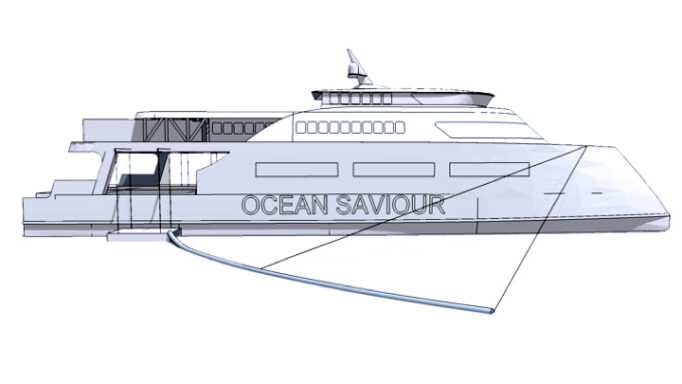
Photo credit: Oceansaviour.org
The project is the brainchild of Richard W. Roberts and Simon White, Founders of TheYatchtMarket.com. Richard Simon conceptualized the project together with some of the world’s top Naval Architects and Yacht designers in an attempt to look at new ways to bring together existing technologies to tackle the extra ordinary plight of our oceans.
Ocean Saviour is the world’s first, self-powering 70m tri-deck clean-up vessel purposely engineered to locate, retrieve, and recycle plastic from the ocean to preserve our most valuable assets for future generations.
FEATURES OF THE OCEAN SAVIOUR
- A forward facing deployable conveyor is located between the hulls
- The front conveyor dips into the water and waste is taken directly onto the deck to be processed
- Manta Collector Array (MCA) booms can be deployed to port and starboard which direct ocean borne plastic waste into an oversized mesh collector
- The content of the MCA and side collectors are craned directly up to the main deck for processing
- Provision has been made to repatriate any wildlife that could be picked up
- There are two plastic recycling processes currently being investigated including plasma gasification or crush bailing. Gasification will produce syngas which may be used to then fuel the vessel
- Ghost nets can be navigated to the rear of the ship for recovery by deck hoists
PULVERIZATION OF MARINE DEBRIS
Another proposal would be Pulverization. Here is an excerpt from the paper’s abstract:
“Here, we proposed a complete eco-friendly low-temperature MD pulverizing system that utilizes excessive liquefied natural gas (LNG) cold energy (LCE) in an LNG propulsion ship to improve the efficiency and effectiveness of MD recycling. The prototype design of the low-temperature pulverization (LTP) system showed that consumable refrigerant (liquid nitrogen) up to 2831 kg per hour could be substituted. Furthermore, with a 20% ship output, 1250 kg of MD could be treated with 363 kg of additional refrigerant. In addition, LTP systems utilizing LCE could increase the storage capacity by more than 10 times compared to bulk MD while minimizing the required energy consumption. To determine the feasibility of LTP for MD recycling, four types of plastics obtained from actual MD from a coastal area in Busan, Korea were classified and tested.”
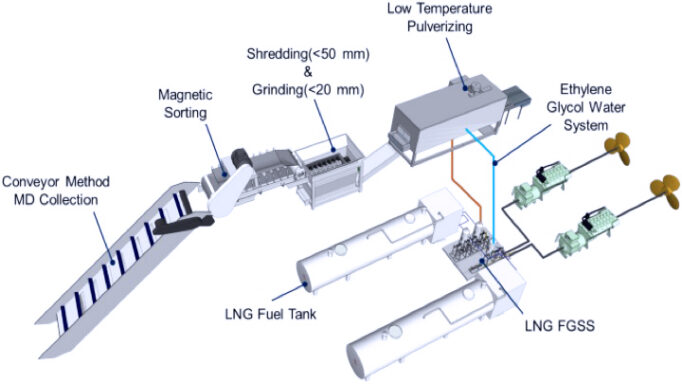
Photo credit: Nature.com
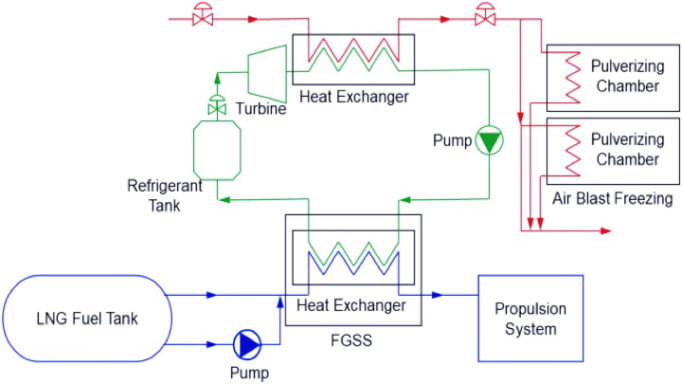
Photo credit: Nature.com
SHIPS THAT RUN ON ALTERNATIVE FUEL
Maybe in the future the Domestic shipping industry namely the Domestic shipbuilding industry can build vessel that run using alternative fuels
LIQUID HYDROGEN
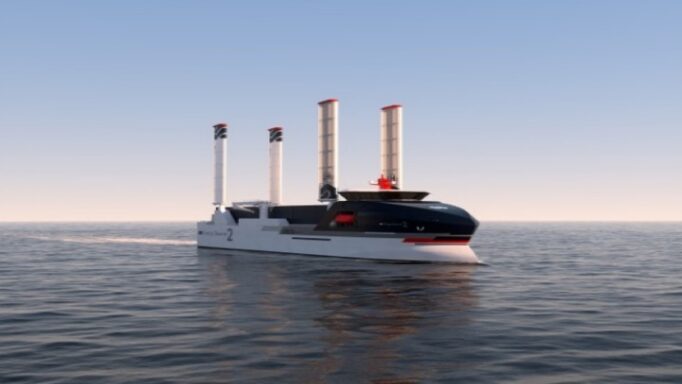
Photo credit: Offshore-energy.biz
“Maritime transport accounts for 3% of CO2 emissions annually on a global scale. The ambition of Energy Observer and its partners is to present prototype solutions leaning towards zero-emission for the transport of goods.
The technologies are now mature, with liquid hydrogen storage well mastered, the deployment of liquefiers around the world, and the latest generations of mass-produced fuel cells. Energy Observer is now tackling the latest technological challenges, such as the integration of large tanks or the management of cryogenic temperatures, thanks to the support of its historical and technological partners.
The main partner of the Energy Observer is Air Liquide, which masters the production, storage, distribution, and safety of liquid hydrogen and thus brings its technical expertise and its capacity for innovation.”
AMMONIA
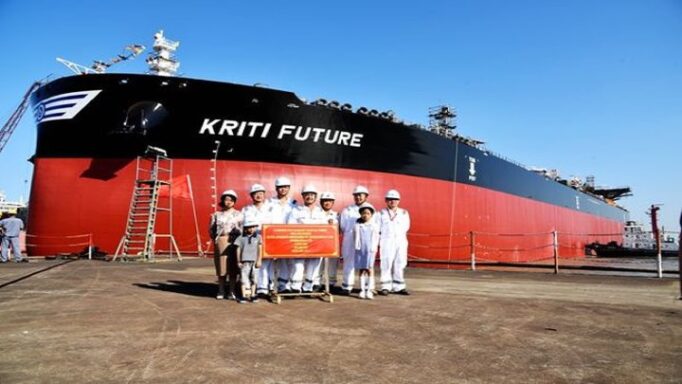
Photo credit: Offshore-energy.biz
“This vessel represents a milestone in the development of the maritime industry and a step forward in the readiness to utilize alternative marine fuels,” Filippos Nikolatsopoulos, ABS Manager, Greece Business Development, pointed out.
As explained by ABS, Ammonia Fuel Ready Level 1 indicates the vessel conforms to the requirements outlined in the ABS Guide for Gas and Other Low-Flashpoint Fuel Ready Vessels. This is part of a suite of industry guidance on alternative fuels developed by ABS, including support for the development of ammonia as a marine fuel.
SHIPBREAKING AND SHIP RECYCLING
Ship Recycling indeed contributes to Maritime Pollution as demonstrated by refusal of any port and recycler to accept an ageing and high maintenance Aircraft carrier form Brazil due to environmental hazards like Asbestos, PCBs and many other toxic materials so they ended up violating three international treaties in sinking or scuttling the Aircraft carrier.
The IMO has set standards for ship breaking and ship recycling through the Hong Kong Convention, by providing guidelines to prevent and mitigate ocean pollution.
The top player for ship breaking is Bangladesh where 92% of the entire world’s ship breaking happens. But its big neighbor India is doubling its capacity for ship breaking and recycling and our neighbor Indonesia through the firm Marco Polo will have its first Green Ship recycling facility.
The World labour organization or ILO also has set standards because ship breaking and recycling is hazardous.
The Philippines has Republic Act 9295 or the Domestic Shipping act with a long title that reads: AN ACT PROMOTING THE DEVELOPMENT OF PHILIPPINE DOMESTIC SHIPPING, SHIPBUILDING, SHIP REPAIR AND SHIP BREAKING, ORDAINING REFORMS IN GOVERNMENT POLICIES TOWARDS SHIPPING IN THE PHILIPPINES, AND FOR OTHER PURPOSES.
MARINA has set the rules and regulations relating to registration and licensing of ship breaking and recycling facilities through its Memorandum Circular No. SR-2020-01.
A June 10, 2020 article in the Manila Times stated:
“The Maritime Industry Authority (Marina) has set up a paid-up capital requirement of P25 million to P50 million for those interested to run ship-breaking and ship-recycling facilities that would support the government’s ship retirement and replacement program.
Marina Administrator Vice-Admiral Robert Empedrad recently signed Memorandum Circular on Shipyard Regulation (SR) 2020-01, which laid the rules and regulations relating to registration and licensing of ship breaking and recycling facilities and for other purposes.
Marina said a Class A ship-breaking or ship-recycling yard must have a paid-up capital of P50 million and must be capable of scrapping ships more than 80 meters in length.
They need to set up a dry-docking facility, wharf or quay, landing or beaching area. The yard should also have a waste reception facilities, sewage treatment plant, and separate storage facilities for hazardous materials.
For Class B ship breaking and recycling yard, the needed capital is P25 million and must be capable of dismantling ships 80 meters in length and below. It must have the same facilities required for a Class A facility.
The ship breaking and recycling business would bring in opportunities for ship yards and ship owners, as long as they follow the environmental sound ship dismantling.”
Despite that, a Shipping giant Tsuneishi halted its plans to setup a Ship breaking and recycling facility in Negros because the project will destroy mangroves.
The Marina Memorandum on Ship breaking and Recycling gives license to ship breakers and ship recyclers if they practice environmentally sound practices. My take on this if the concern is the mangroves will be destroyed then the one of the options is to find another location which is not easy, then the responsible way is to continue the efforts on mangrove replanting by all the stakeholders including the ship builders.
India did an extensive report on Maritime pollution coming from Ship breaking.
The aforementioned plasma gasification has potential to contribute to up the value of the recyclables from ship breaking.
SOME LAUDABLE EFFORTS IN THE PHILIPPINES
Community efforts in estero cleanup, coastal cleanup, The Ocean Cleanup Day, and MARINA and PCG’s initiative to protect The Marine Environment are laudable.
Despite our number three ranking in the top plastic polluters, there are small efforts that contribute immensely like the estero cleaning of both Metro Manila water concessionaires Manila Water and Maynilad and The project of the former DENR secretary General Roy Cimatu of a simultaneous estero cleanup which should be continued and replicated forevermore.
The use of trash traps to prevent garbage reaching Manila bay may not be as sophisticated as Boyan Slat’s Interceptor but it gets the job done. The third Sunday of September is the International Ocean Cleanup Day and The Philippines contributed its share in the efforts. Another laudable initiative is MARINA and PCG’s initiative to protect the Marine Environment.
MEPSEAS PROJECT
Last 2018, Seven ASEAN countries launched an ambitious initiative called the Marine Environment Protection of the Southeast Asian Seas or the MEPSEAS Project aimed at improving the environmental health of the seas through implementation of International Maritime Organizations treaties. Seven ASEAN countries have formally launched an ambitious initiative aimed at improving the environmental health of the seas in the region, through the implementation of key International Maritime Organization (IMO) marine environment protection treaties. The project was funded by Norway through NORAD and the ASEAN Maritime Transport Working group served as the advisory body.
MEPSEAS implemented four high priority treaties including the International Convention For the Prevention of Pollutions from Ships(MARPOL); the Anti-Fouling Systems Convention; the London dumping of wastes at sea convention and protocol; and the Ballast Water Management Convention.
CONCLUSION
There is indeed a large room for improvement for The Philippines’ contribution to Maritime Pollution Prevention and Maritime Environment Protection, but there are so many promising opportunities out there and our efforts to mitigate pollution should be lauded.
Ship breaking and ship recycling indeed is an opportunity since we have lots of old ships, but making sure to follow environmentally sound practice like adhering to international treaties is a must.
Lastly, for the Southeast Asian Region, NORAD is supervising the implementation of the Marine Environment Protection of Seas or MEPSEAS.
About the Author:
Karl Misa Garcia’s interest in the Maritime Industry goes way back when he was an employee of Asian Terminals, a port operator at the South Harbor Port of Manila. But his interest in everything maritime maybe in his DNA being a son of a former Navy Officer. He also had a stint as a consultant to Senators Biazon and Trillanes. He is a graduate of BS Computer Science from AMA Computer University. He earned his MBA from De La Salle University Graduate School of Business.

Continue planting the seed!
Thanks
Many Thanks sir Francis